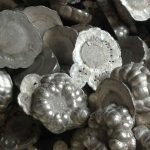Notice: Undefined index: sith_hide_share in /www/sites/alloy.wiki/index/wp-content/themes/likegoogle/single.php on line 32
Deprecated: get_settings is deprecated since version 2.1.0! Use get_option() instead. in /www/sites/alloy.wiki/index/wp-includes/functions.php on line 4862
1.Influence of in-plane heterogeneity on sheet formability
Different performances in different directions with respect to the rolling direction of the titanium plate, so that the deformation of the cylindrical forming part has become axisymmetric, and lugs have appeared on the forming part. In addition to the appearance of the lugs, the shape of the formed part does not meet the requirements (belonging to the conformity category), and the degree of allowable deformation is also unfavorable.

Obviously, the appearance of the lugs on the cylinder-shaped part will inevitably cause the shrinkage and deformation in the direction of the cylinder to be unevenly distributed on the cylinder. The valleys are large, the lugs are small, and the valleys are more prone to unstable wrinkles or shears. Cut cracked. If the deformation is evenly distributed, such wrinkling or cracking can be avoided, or at least it will occur under a larger deformation.
The impact of the lug on the deformation is not only in the valley, but also in the direction of the lug; the performance is that the forming part is located in the direction of the lug and the material at the four corners of the die will be cracked. This is due to the width of the wool protruding line of the lug part, and the force required for further deformation must be larger. When it is large enough, the largest part of the force-the fillet of the die will be cracked.
Of course, for non-axisymmetric parts, according to the specific conditions of the part, the blanking orientation is appropriately selected, and the in-plane heterogeneity is used to turn it into a favorable factor, which can sometimes increase the allowable deformation.
The influence of heterogeneity on the conformal surface of the palatal plane is also manifested in curved parts. Due to the in-plane anisotropy of the material, that is, the nature of the principal strain direction does not always coincide with the direction of the principal stress, so that the bending line is not a bending piece consistent with the rolling direction or the transverse direction of the plate, it seems that it should not happen intuitively wry.
异 Titanium plate has significant adverse effects in the anisotropy, and it is particularly prominent in shape. Due to the different performance in different directions, even if the forming pair has the same stress, different springbacks will occur during unloading, which will cause the shape distortion of the formed part, that is, the original plane will warp.
2. The effect of surface heterogeneity on sheet formability
As mentioned above, the typical manifestation of surface anisotropy is that the stressed flat plate no longer maintains a flat surface and appears to be curved. Obviously, properly placing the wool during the forming process so that the forming curvature is consistent with the curvature caused by the surface anisotropy will facilitate the forming of the part and increase the allowable deformation degree; otherwise, it will reduce the allowable deformation degree. For example, TCIM material with a thickness of 1.5 mm has obvious surface anisotropy. When the round hole is flanged, if the side with a larger thickness anisotropy index is the inner surface of the flanging member, its limiting flanging coefficient can be higher than when it is on the outer surface. Big 2.8%.
Since surface anisotropy can produce undesired changes in curvature, it generally has a negative impact on conformability and settability.
Guest contributors are welcome at the Alloy Wiki.It is a weekly wiki and guide on alloy information and processing technology, while also about the vast array of opportunities that are present in manufacturing. Our team of writers consists of a Machining Material Supplier / Machinist / Tool and Die Maker, a Biomedical Engineer / Product Development Engineer, a Job Development Coordinator / Adjunct Professor, and a President and CEO of a manufacturing facility.
Link to this article:Effect of In-Plane Anisotropy and Surface Anisotropy on Titanium Plate Formability
Reprint Statement: If there are no special instructions, all articles on this site are original. Please indicate the source for reprinting:Alloy Wiki,thanks!^^


